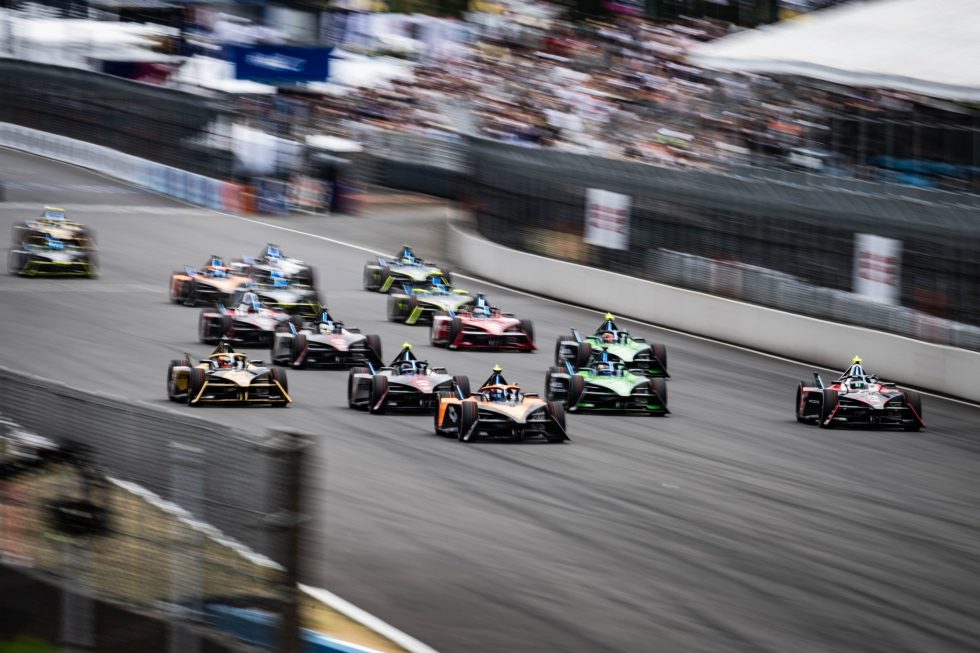
Sam Bagnall/Formula E
PORTLAND, Ore.—Formula E wraps up its 10th series with a pair of races in London this weekend. It’s been a competitive manufacturer’s championship between Porsche and Jaguar. This weekend, seven drivers are still in contention to win the driver’s title after a double-header in Portland on June 29-30 that saw cars going five-wide down the main straight as they reached the highest top speeds of the season. It was the second visit by Formula E to the picturesque Portland International Raceway, and Ars spoke with some of the sport’s bigwigs to see what they think it’s getting right and where the technical evolution of the cars is headed.
Formula E has come a long way since 2014. Racing then exclusively in city centers, the cars were slow at first. And even as they developed, they carried too small a battery to complete even a relatively short race distance. There was a big upgrade in 2018 with the start of season five: The Gen2 car now has battery packs sufficient for 45 minutes-plus-a-lap races. The Gen2 car raced well, too, even putting on a better show at Monaco than Formula 1 has been able to muster for decades.
We expected another big improvement in lap times when the Gen3 car arrived at the start of last season. The Gen3 car featured much less weight and much more power, but also a change of tire supplier. Originally meant to last multiple race weekends, the rubber supplied by Hankook this season and last has much less grip than the Michelins it replaced. That’s kept cornering speeds relatively low and made the cars even harder to drive.

Sam Bagnall/Getty Images.
That is not necessarily a bad thing, as the series has always written the rules to make things hard on the drivers and teams. For example, while the battery packs are larger now, they still don’t actually have quite enough charge to complete a race distance without careful energy management. But while the race officials get data-rich telemetry streams from all the cars during a race, the teams have to rely on each driver keeping tabs on their own state of charge and reporting that back via radio to the engineers in the garage so the boffins can calculate the optimal strategy.
More technical changes are in store. In 2025 and 2026, the series will move to the Gen3 Evo car, which will have on-demand all-wheel drive and more grip from better tires, among other tweaks. Meanwhile, everyone in Formula E has been thinking hard about Gen4, which is due to arrive for season 13.
What has worked?
I asked Formula E CEO Jeff Dodds, as well as some of the team principals, to start off by blowing their own horns a bit—what’s Formula E been doing right? “We’ve just announced our Gen3 Evo car, which gets to 60 miles an hour in 1.8 seconds, and we’re still an infancy business, only 10 years old, still playing around with early tech. So I think over time, a massive strength of ours is how that technology allows performance of the car to improve,” Dodds said.

Simon Galloway/Formula E
McLaren team principal Ian James, who previously led Mercedes to a Formula E championship before it quit the sport, was proud of how far Formula E has come over the last decade. “Gen2 really saw a step forward in that respect and a professionalization of the whole series. I think with Gen3 we’re really starting to unlock the performance potential of electric motorsport. And we’re going to see that take another notch up in Gen3 Evo,” James said.
Existing as a relevant arena for electric vehicle R&D is Formula E’s big strength, according to Nissan team principal Tommaso Volpe. “Representing a big car manufacturer in the sport I think the main strength is how relevant it is for a big transformation that is happening in mobility… using electrification as a key technology,” Volpe said. This is something that the motorsports cannot claim. They have other strengths, but they can not claim to be that relevant, purely speaking from the R&D perspective,” Volpe said.
For a company like Nissan, the primary benefit is still getting its EV tech in front of eyeballs, something Formula E’s deal to stream races live over Roku has no doubt helped. But there are other benefits to participation. “You cannot use the same motor, but the efforts that we put in place when we develop a Formula E car, in maximizing the energy efficiency of the hardware—so the materials we use, the solutions, the design—is something that is absolutely relevant for the core business and you can transfer some of these ideas and experience,” Volpe said.




















+ There are no comments
Add yours